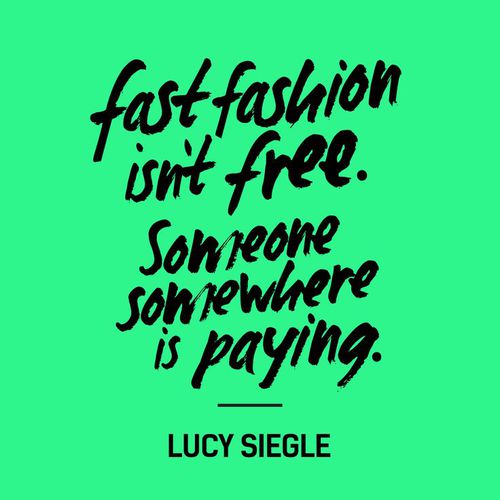Walking along the Hudson River, on the very edge of the city of Hoboken, my friend and I were enjoying the night sky after work when she said she missed looking out and seeing the Twin Towers. It’s not that we forget; as a person who was from the city, lives in the city now, or lived when a tragedy happened: that memory doesn’t wash away. There is always a piece of tragedy stuck within you. When reading through the Fashion Revolution website, I am reminded again that fashion production needs transparency when I think of another tragedy: The Rana Plaza building in Dhaka that may have killed an almost 30-billion-dollar industry, but more importantly, the lives of those who were lost is an outrage to this day. From “4 Years After Rana Plaza Tragedy, What’s Changed for Bangladeshi Garment Workers?”, Westman writes:
“But four years later, a report on supply chain transparency released by Human Rights Watch finds only 17 of 72 apparel and footwear companies contacted by a coalition of labor and human rights groups and global unions have agreed to implement a transparency pledge by the end of this year”.1
Why is it that demand for human rights are only sparked out of these tragedies? What takes us, as consumers, and as people, to realize that we cannot afford a tragedy to spark action? After years of remembering the terror, we are still left with a strong fight to demand that our labor rights are protected. It was only last semester that through my own research in New York’s Garment Industry history that I found an article on from 1983 that talked about the rise of sweatshops; From “AFTER YEARS OF DECLINE, SWEATSHOPS ARE BACK”, Serrin states:
“The new sweatshops are in Chinatown, on Roosevelt Avenue in Queens, on Jerome Avenue in the Bronx, in Long Island City, in West New York and Jersey City in New Jersey and in other places – places where men and women, including many illegal immigrants, toil at low wages, for long hours and often in hot, bleak, unsanitary and unsafe conditions”.2
Exactly 20 years later, we had Rana Plaza. We had the same packed floors, heated work environments and no legal repercussions that makes a statement to our world that the problem is not in decline. How many more sweatshops, or illegal garment production environments must collapse before we demand transparency in fashion production, and not just simple hope for it?
Garment industry unions have declined, as well. On the Fashion Revolution page, the Garment Worker Diaries has painted an accurate portrait of the every day lives of the garment workers today in Bangladesh, China, and India3. In Bangladesh, workers are enringing minimum wage at 60 hours a week, compared to China and India; workers still report, from the MFO, that they don’t feel safe in the work environments.3 Again, I am astonished to read that reports I studied from the Progressive Era sound familiar to statements made in late 20th Century about age, gender, and sex discrimination4. With the demanding and illegal work environments, the same disgust grows from harassment in the work place. For example, to put a timeline in prospective, in 1909, before the devastation of the Triangle Shirtwaist Factory occurred, workers from the Triangle Shirtwaist Factory demanded improvements to the 14-hour long job they endured everyday where bathroom breaks occurred on the shop floor. After the disaster in September of 1909 with The Triangle Shirtwaist Factory, the police chief of New York City in 1911, Theodore Bingham, guessed that over 2,000 foreign women were enslaved in brothels after being brought into the United States5. It’s as if we moved backwards, especially fast forwarding to when the Rana Plaza collapse occurred. It makes transparency even more prevalent in 2018 as a call to finally say “we have had enough”.
To follow the trend of the Fashion Revolution, and out of the horror I have had to research, I have sent out my own agenda; using the hashtag #whomademeclothes, I am sick of researching the non-changing statistics and want to really know: who is making the clothing I buy, and sell (working in retail), every single day that could cost the life of someone here in New York, or overseas? So, I have a simple story: I bought shoes for $1.00 at Francesca’s the other day and I tweeted them the answer I want:

Maybe there was a great sale, or I missed something in that moment of exchange at the Francesca’s I shopped at, but I want to know where my shoes are from. It’s small step, but one we should all take. I will post on updates to come on if anyone responds to my tweet, but I won’t give up the fight to try to avoid another article of tragedy to occur. What we need is the action and demand to make sure the literature of the future talks about garment industry illegality and poor work conditions in the past tense, not the present. For now,
Carolyn J Cei
Demand transparency here: http:///fashionrevolution.org/
References
1 4 Years After Rana Plaza Tragedy, What’s Changed for Bangladeshi Garment Workers? Parallels : NPR. https://www.npr.org/sections/parallels/2017/04/30/525858799/4-years-after-rana-plaza-tragedy-whats-changed-for-bangladeshi-garment-workers. Accessed 23 Apr. 2018.
2 “Home.” Fashion Revolution, https://www.fashionrevolution.org/. Accessed 23 Apr. 2018.
3 Bangladesh_Data_Portal. http://workerdiaries.org/gwdiaries/bangladesh/story_html5.html. Accessed 23 Apr. 2018.
4 Serrin, William. “After Years of Decline, Sweatshops Are Back.” The New York Times, 12 Oct. 1983. NYTimes.com, http://www.nytimes.com/1983/10/12/nyregion/after-years-of-decline-sweatshops-are-back.html.
5 Smolak, Smolak, and Alex Smolak. “White Slavery, Whorehouse Riots, Venereal Disease, and Saving Women: Historical Context of Prostitution Interventions and Harm Reduction in New York City during the Progressive Era.” Social Work in Public Health, vol. 28, no. 5, 20130801, pp. 496–508.
Top image credit: https://weheartit.com/Carmen3421

